In last week’s news: DeepMind announced that their sophisticated AlphaStar AI is now better than 99.8% of all human players in the Blizzard Entertainment game StarCraft II. The news was published on 30 October in Nature. Robot uprising, anyone?
It’s two decades into the 21st century already, but the much-predicted robot apocalypse never happened. Still, the subject of artificial intelligence and its potential is exciting and agitating people’s minds.
Look at the movie industry, and I’m not talking about “Space Odyssey 2001”. Consider the last five years: there’s “Ex Machina”, “Blade Runner 2049”, “Alita: Battle Angel”, and ok, “Avengers: Age of Ultron”. Dozens of other movies broached the subject of AI and its possibilities with “Terminator: Dark Fate” currently in theaters. And it’s not all about movies. For example, people are wondering whether there will be an AI in the hyped upcoming “Cyberpunk 2077” video game.
They say that sci-fi has been experiencing a crisis for some time, but as you can see, the theme of AI is very much alive. And the culture is a mirror to society. AI is everywhere.
Siri and Alexa are simple examples of how AI-powered technology has become a part of our daily lives. But there’s also AI design in social media, smartphone cameras, in managing home energy usage.
I don’t even have to go far to illustrate my point. I’m writing this article in Google Docs with Grammarly installed. It’s a digital writing tool using artificial intelligence. Mind you, I turn it off while working, otherwise, it’s too distracting. But it’s useful to have texts proofread, it catches dumb moments and typos, provides a selection of synonyms, etc. And there are a lot of more sophisticated tools for writers than Grammarly.
But what does AI mean for UX? Let’s find out what is the current state of AI in UX, how it might be useful for the stronger UX, and whether AI can substitute designers altogether.
Contents:
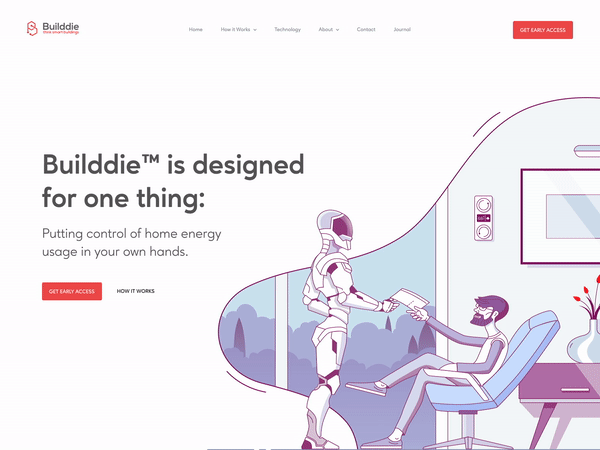
Builddie Homepage Animation by Eugene Machiavelli for Shakuro
The current state of AI in UX design
The possibilities of AI and machine learning in UX design is one of the hottest trends for 2020. Recently the UX research platform UserZoom conducted a survey where they found out that 80% of UX executives believe that UX design and AI are the future of user experience. This figure was only 66% last year.
A lot of organizations are already participating in this competition. They want to make the UX of their products more intuitive with the help of AI technology. Last year Narrative Science and the National Business Research Institute made a survey on the subject of artificial intelligence in the Enterprise. Almost two-thirds of companies reported that they’d already made AI part of their businesses. This is twice as much as in 2016. In a different study, 61% of marketers said that AI is a crucial aspect of their business strategy in general.
I see why this is happening. Soon, users will be satisfied only by this degree of user experience. And UX design is all about making people’s experiences with digital products more straightforward. It should remove the hitches that make the user-brand connection more difficult. Effortless UX design equals user-friendliness. AI is just the right tool for using personalized behavioral information to drive up conversions. As a result, companies get to know their clients better and people are more likely to engage. On top of that, a brand’s profits rely on effective customer engagement.
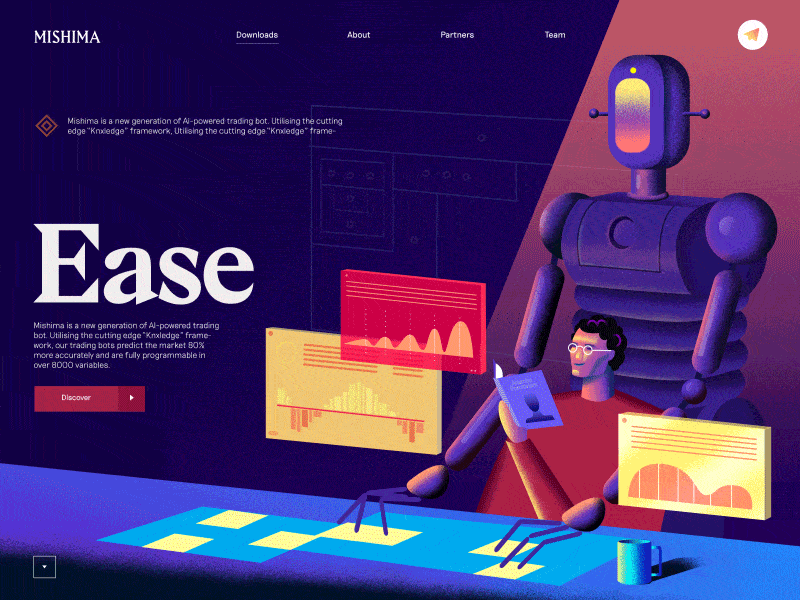
M I S H I M A 0 0 1 by Zak Steele-Eklund
So what are the examples of AI usage in the world of UX?
Personalized user experience
Customers are becoming more demanding. They are no longer satisfied with nice-looking UI, colorful animations and smooth user flow. These are the things that they expect to have, not something fresh and exciting. People want more. Today we like to feel that their communication with brands is personal. Only when they have a feeling of personal communication, are they ready to express their loyalty and choose one brand among others.
The most significant advantage AI can give is improved personalization. It uses the data collected by the system to tailor the site to the needs of the user like tailoring a suit.
73% of Internet users are extremely annoyed when showed irrelevant content. AI allows demonstrating to each user the interface that he needs. It means that users will see only those tabs, menu items, applications, etc. that they need. Clients enjoy interacting with the site more, which increases sales.
And here’s a thought that can seem unexpected: AI creates more profound human connections between people. Ironically, the reality is that artificial intelligence helps to humanize brands and make them more approachable.
Among the companies that use personalization to its full extent is Netflix. There are too many movies and TV shows there to choose from. Users need a little push in the right direction. According to Netflix, 75% of their views come solely from personalized recommendations. Netflix’s recommendation algorithm is one of the most powerful and complex examples of mathematics you can experience every day without even knowing it’s where.
Google produces personalized search results that depend on many factors like user location, search history, demographics, and interests. For example, if you do a search for “pizza restaurant” your search results would vary considerably from mine.
Google’s Youtube tracks viewing history and offers recommendations that are personalized to each user’s viewing habits.
If we go deeper into what AI cand do for UX, we’ll discover that AI has the potential to generate an advanced personalized messaging system. Future users will settle for nothing less than messages personalized according to their concerns and problems. Including AI interactive ads that are already being developed.
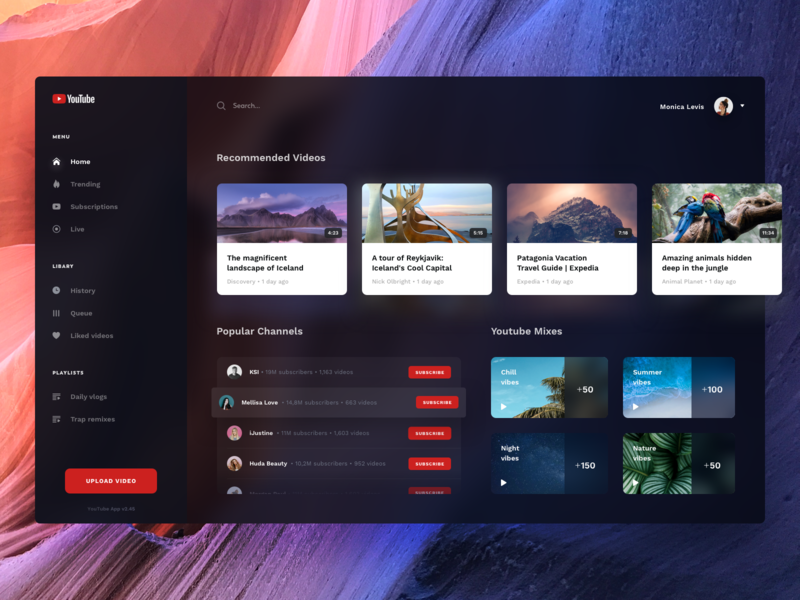
YouTube – desktop application concept by Filip Legiersk
AI chatbots
Chatbots are great for providing efficient customer service and advertising new products and services. Many large companies are using chatbots as a part of their business strategies. You can order food and taxi, arrange flights, and get recommendations for anything you can think of, including applications acting as personal fitness coaches. In a report by Gartner, it’s stated that 85% of customer interaction will be handled without human agents by 2021.
Yet, a report by Forbes reveals that people are 80% less likely to make a buy if they sense that they communicate with an unempathetic robot. That is why more and more businesses are requesting for chatbots that possess a sense of empathy, advanced interactiveness, and the ability to turn users’ emotions into data and then perform sentiment analysis. The solution is to recognize the target audience, identify with them and their issues, and help resolve them.
The most enjoyable part is that with chatbot marketing you can get as creative as you want. There’s an amusing story of a UX designer Steph Hay who helped create the first gender-neutral AI assistant in banking. Eno chatbot is so good, people want to marry it.
Chatbots that can perform sentiment analysis are even creating new jobs. Chinese market analysis company QYReports estimates the AI sentiment analysis market to increase by 21% every year from 2019 to 2025.
Facebook in its turn struggles not to lag behind Amazon and Apple and has been working on a voice assistant to compete with Alexa and Siri. The news is they could use it on the company’s Portal video chat smart speakers.
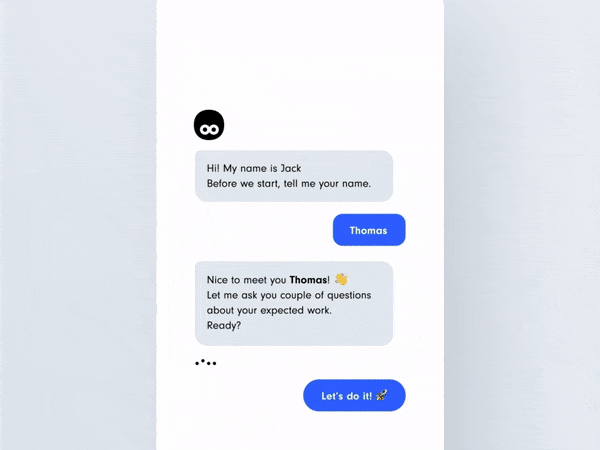
Jack AI Employment Agent – Chatbot by Maciej Dyjak
AI in web design
These days, people have several possibilities of creating a website. You can base it on a template, use web design tools like Webflow, or order a custom-made design by a team of professionals.
Artificial design intelligence or ADI is trying to change the idea behind web design with AI experiments. In 2016, the web development platform Wix revealed its ADI tool to automatically create a customizable homepage for personal or corporate needs. Besides Wix, several other platforms use AI in web design on a more superior level: AiDA from Bookmark and Sacha from Firedrop.
Then again, there’s an infamous example of the Grid, a web design tool that was intended to be the first single window in AI web design. It made a sensational debut, but in reality, it never met its exaggerated promises. The websites its artificial intelligence software made were inflexible, with less capability than was promised, and plainly said, not so great in terms of aesthetics. The Grid company sent its last public tweet on December 10th, 2017. In March 2019 all customer websites are taken down, and thegrid.ai, where customers sites were hosted, ceased to be functional.
Machines aren’t capable to match professional web designers yet, and they never really will. Anything more complex than a little brochure site, and the difference is staggering. So, designers have no real reason to get worried about their job security being compromised by this type of service.
Web design made by AI robots:

Wix real estate website template
Web design made by humans:
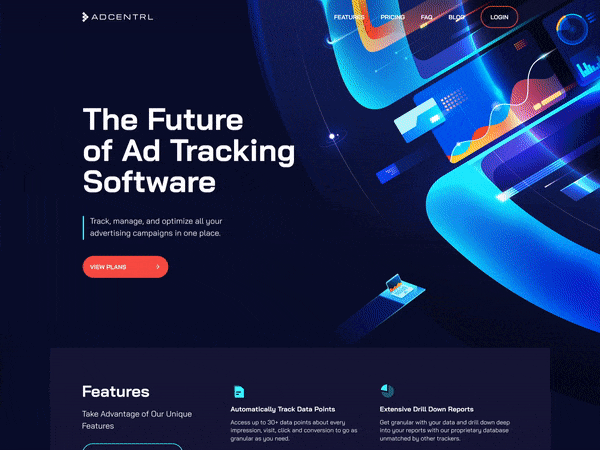
AdCentrl Homepage Scrolling Animation by Alex Kalinichenko for Shakuro
AI prototyping tools for designers
UX design is a creative job, but even UX designers cannot do whatever they want. They must be aware of the latest trends, meet the current market demand, and use new tools to stay successful in today’s competitive world.
All in all, swift technological progress has inspired a whole new generation of UX designers. They rely on new tech to make UX more user-centered and all-round more efficient. For example, they use prototyping tools.
A prototyping tool lets designers see in advance the outcome of their work without having to finish the whole project and with less time spent on the job. Just a few sketches are needed. AI system quickly moves ideas from rough sketches to real life.
The most famous cases are Airbnb and Uizard. They designed AI systems that can recognize hand-drawn parts and pass them into the code. It simplifies the development process and gives more time to concentrate on more important aspects.
The top 5 prototyping tools for UI/UX designers are:
- Airbnb’s AI
- Uizard
- Mockplus
- InVision
- Balsamiq
Artificial intelligence limitations
However, AI and its capabilities in UX are not all that it’s cracked up to be just yet. Humans often have unrealistic expectations from artificial intelligence, while in reality, it’s still in its nascent stage of development.
AI use in applications is great, but you have to tell it exactly what to do and to develop it using feedback. Once you tune it to its performance, only then can it become effective.
A great example is self-driving cars. Many people believe that, because it’s a machine, it should be 100% effective and reduce car accidents rate to 0%. In fact, the first thing we should strive at is making the accident rate of AI-driven cars the same as human drivers’ and then try to develop the situation further. Steady progress, as with everything else.
Microsoft is already testing a smartphone-based AI system for driving license tests in India. Their claim that replacing human driving instructors with AI technology is possible, but is it though? Take a couple of minutes to appreciate a great job The Washington Post did to interactively illustrate how autonomous cars work in reality. Spoilers: not so great.
AI systems still have a long way ahead of them. They are able to provide personalized solutions to an extent but they still can’t offer human-degree customer service. People are somewhat wary of robots, the lack of desirable empathy can be annoying, and machines don’t have the common sense you’d expect from humans.
Machines can teach themselves, but still, they are not capable of thinking on their own. But then again, maybe they shouldn’t. AI’s purpose is to help and assist people with their tasks to make their lives easier and more productive.
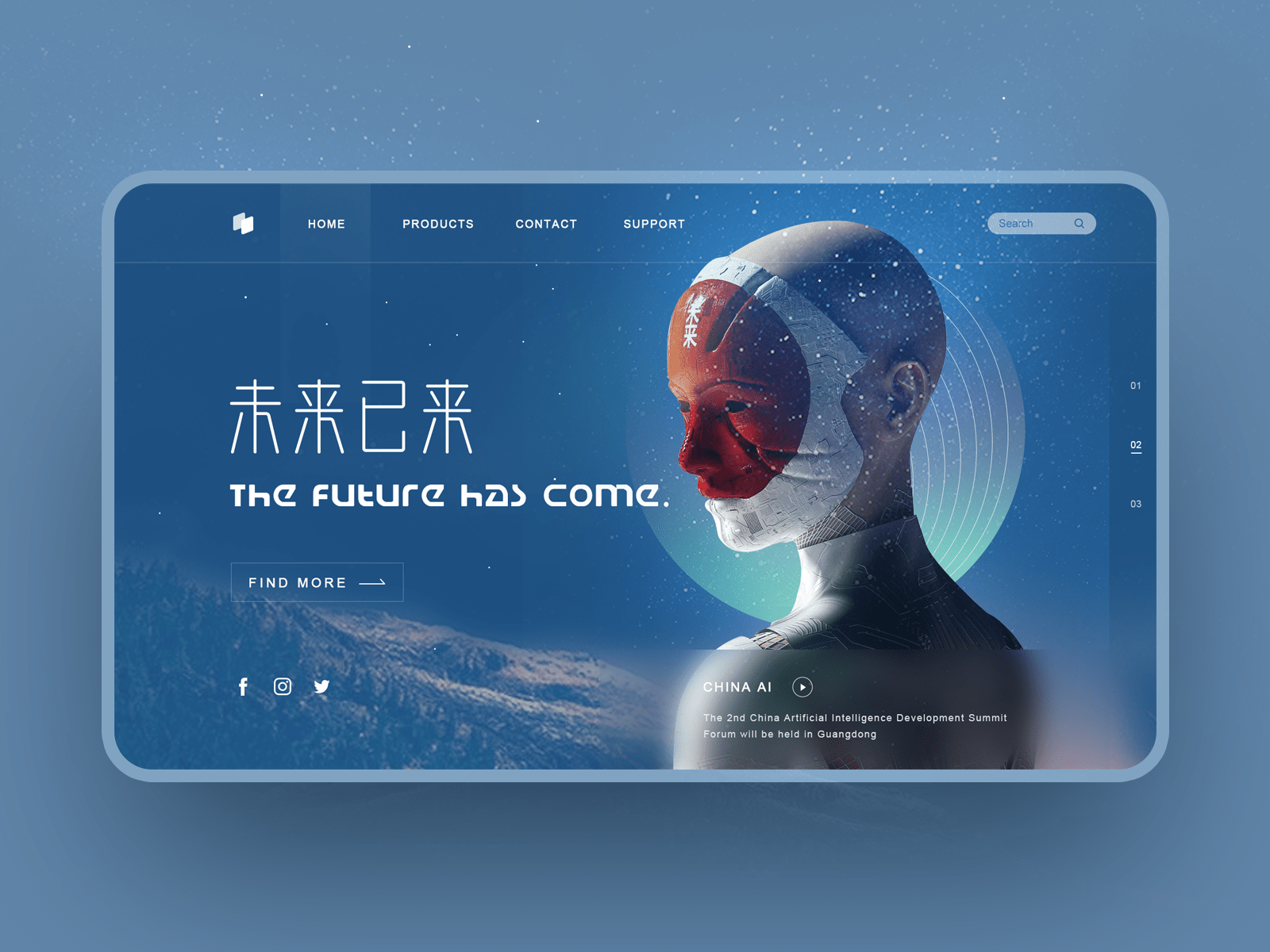
AI Web Design by Howard Chen
Which brings us to the conclusion and the point I’ve decided to leave for the last. The possibility of designers to be replaced by robots.
In conclusion: People won’t be replaced by robots
It may all sound like a sci-fi movie, but the actual truth is that AI strengthens the UX in ways that can’t be compared to any other technology or marketing strategy. It can make a brand-user interaction far more personal, get and use highly-valuable data, free humans from simple tasks and much more. It’s useful. But what if it’s too useful – more than it’s comfortable for us humans?
It looks like every few months or so a report alerts us about the future where lots of people will lose their jobs because of artificial intelligence. To pick one, an Oxford University study prophesied that half of the jobs in the US could be automated by 2033. But if we take a glance at history, we’ll see that it’s not so doom-and-gloom as it may seem.
Another study based on an analysis of 170 million job postings from 2010-2017 states that as technology reduces the cost of some tasks, the value of the remaining tasks increases. Any profession that needs a high level of creativity, innovative thinking, and experience isn’t likely to disappear in your lifetime. AI is far from providing all the said skills.
A considerable part of any person’s work isn’t creative. Sometimes professionals spend a lot of time performing less imaginative and more mundane tasks that machines are able to perform in a fraction of the time. Here’s where AI can prove effective. The thing is not making people redundant, but to free them to spend more time on the artistic, beautiful and fun bits of their jobs.
In words of Burton Rast, UX Lead at Google,
“When the tractor was invented, the farmers got scared out of their minds – it seemed to be robbing them of their work. There’s no need in following the fears. You just need to look more for advantages rather than disadvantages in the new technology, and the fear will disappear by itself. Any new technology devalues existing professions and at the same time offers new ones in return. We can’t even imagine what specialists will be in demand in a hundred years.”
